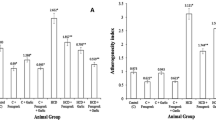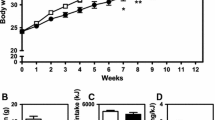Abstract
Onion peel (OP) extract is known as a rich source of flavonoids, mainly quercetin. We hypothesized that OP has hypocholesterolemic effects. To investigate the effect of OP, C57BL/6J mice were divided into 4 dietary groups (n=10); normal diet (ND); high cholesterol diet (HC); and high cholesterol diet with 100 or 200 mg OP extract (OP-100 or OP-200, respectively) per kg of body weight. After 12 weeks, lower values of liver weight, serum total cholesterol levels, LDL cholesterol, atherogenic index, cardiac risk factor, hepatic triacylglycerol, and total cholesterol, and higher fecal cholesterol levels were observed in the OP-200 than in the HC group. The hepatic mRNA expression levels of low-density lipoprotein receptors (LDL-R) and cholesterol 7-alpha-monooxygenase (CYP7A1) were high in the OP-200 compared to the HC group. These observations suggest that OP promoted lowering of serum and hepatic cholesterol in mice primarily via fecal excretion.
Similar content being viewed by others
References
Anandharaj M, Sivasankari B, Parveen Rani R. Effects of probiotics, prebiotics, and synbiotics on hypercholesterolemia: A review. Chinese J. Biol. Article ID 572754 (2014)
Asahina M, Sato M, Imaizumi K. Genetic analysis of diet-induced hypercholesterolemia in exogenously hypercholesterolemic rats. J. Lipid Res. 46: 2289–2294 (2005)
Popkin BM. Global nutrition dynamics: The world is shifting rapidly toward a diet linked with noncommunicable diseases. Am. J. Clin. Nutr. 84: 289–298 (2006)
Golomb BA, Evans MA. Statin adverse effects: A review of the literature and evidence for a mitochondrial mechanism. Am. J. Cardiovasc. Drug. 8: 373–418 (2008)
Fuentes F, López-Miranda J, Sánchez E, Sánchez F, Paez J, Paz-Rojas E, Marín C, Gómez P, Jimenez-Perepérez J, Ordovás JM, Pérez-Jiménez F. Mediterranean and low-fat diets improve endothelial function in hypercholesterolemic men. Ann. Intern. Med. 134: 1115–1119 (2001)
Mirmiran P, Noori N, Zavareh MB, Azizi F. Fruit and vegetable consumption and risk factors for cardiovascular disease. Metabolism 58: 460–468 (2009)
Theuwissen E, Mensink RP. Water-soluble dietary fibers and cardiovascular disease. Physiol. Behav. 94: 285–292 (2008)
Hertog MG, Feskens EJ, Hollman PC, Katan MB, Kromhout D. Dietary antioxidant flavonoids and risk of coronary heart disease: The Zutphen Elderly Study. Lancet 342: 1007–1011 (1993)
Bae CR, Park YK, Cha YS. Quercetin rich onion peel extract suppresses adipogenesis by downregulating adipogenic transcription factors and gene expression in 3T3L1 adipocytes. J. Sci. Food Agr. 94: 2655–2660 (2014)
Kim OY, Lee SM, Do H, Moon J, Lee KH, Cha YJ, Shin MJ. Influence of quercetinrich onion peel extracts on adipokine expression in the visceral adipose tissue of rats. Phytother. Res. 26: 432–437 (2012)
Gülsen A, Makris DP, Kefalas P. Biomimetic oxidation of quercetin: Isolation of a naturally occurring quercetin heterodimer and evaluation of its in vitro antioxidant properties. Food Res. Int. 40: 7–14 (2007)
Singh BN, Singh BR, Singh RL, Prakash D, Singh DP, Sarma BK, Upadhyay G, Singh HB. Polyphenolics from various extracts/fractions of red onion (Allium cepa) peel with potent antioxidant and antimutagenic activities. Food Chem. Toxicol. 47: 1161–1167 (2009)
Pichiah PB, Moon HJ, Park JE, Moon YJ, Cha YS. Ethanolic extract of seabuckthorn (Hippophae rhamnoides L) prevents high-fat diet–induced obesity in mice through down-regulation of adipogenic and lipogenic gene expression. Nutr. Res. 32: 856–864 (2012)
Teratani T, Tomita K, Suzuki T, Oshikawa T, Yokoyama H, Shimamura K, Tominaga S, Hiroi S, Irie R, Okada Y, Kurihara C, Ebinuma H, Saito H, Hokari R, Sugiyama K, Kanai T, Miura S, Hibi T. A high-cholesterol diet exacerbates liver fibrosis in mice via accumulation of free cholesterol in hepatic stellate cells. Gastroenterology 142: 152–164 (2012)
Ryu MH, Cha YS. The effects of a high-fat or high-sucrose diet on serum lipid profiles, hepatic acyl-CoA synthetase, carnitine palmitoyltransferase-I, and the acetyl-CoA carboxylase mRNA levels in rats. J. Biochem. Mol. Biol. 36: 312–318 (2003)
Nakamura Y, Ishimitsu S, Tonogai Y. Effects of quercetin and rutin on serum and hepatic lipid concentrations, fecal steroid excretion and serum antioxidant properties. J. Health Sci. 46: 229–240 (2000)
Egert S, Wolffram S, Westphal AB, Saadatmandi CB, Wagner AE, Frank J, Rimbach G, Mueller MJ. Daily quercetin supplementation dose-dependently increases plasma quercetin concentrations in healthy humans. J. Nutr. 138: 1615–1621 (2008)
Askari G, Hajishafiee M, Ghiasvand R, Hariri M, Darvishi L, Ghassemi S, Iraj B, Hovsepian V. Quercetin and vitamin C supplementation: Effects on lipid profile and muscle damage in male athletes. Int. J. Prev. Med. 4(Suppl 1): S58–S62 (2013)
Park SH, Huh TL, Kim SY, Oh MR, Tirupathi Pichiah PB, Chae SW, Cha YS. Antiobesity effect of Gynostemma pentaphyllum extract (actiponin): A randomized, doubleblind, placebocontrolled trial. Obesity 22: 63–71 (2014)
Wilson PW, Garrison RJ, Castelli WP, Feinleib M, McNamara PM, Kannel WB. Prevalence of coronary heart disease in the Framingham Offspring Study: Role of lipoprotein cholesterols. Am. J. Cardiol. 46: 649–654 (1980)
Wu JH, Qing-Hua Wang QH, Li F, Shu YL, Chan CO, Mok DKW, Chan SW. Suppression of diet-induced hypercholesterolemia by turtle jelly, a traditional Chinese functional food, in rats. Evid.-Based Compl. Alt. Article ID 320304 (2015)
Turner S, Voogt J, Davidson M, Glass A, Killion S, Decaris J, Mohammed H, Minehira K, Boban D, Murphy E, Luchoomun J, Awada M, Neese R, Hellerstein M. Measurement of reverse cholesterol transport pathways in humans: In vivo rates of free cholesterol efflux, esterification, and excretion. J. Am. Heart Assoc. 1: e001826 (2012)
Yang TT, Koo MW. Chinese green tea lowers cholesterol level through an increase in fecal lipid excretion. Life Sci. 66: 411–423 (1999)
Igarashi K, Ohmuma M. Effects of isorhamnetin, rhamnetin, and quercetin on the concentrations of cholesterol and lipoperoxide in the serum and liver and on the blood and liver antioxidative enzyme activities of rats. Biosci. Biotech. Bioch. 59: 595–601 (1995)
Nwagha UI, Ikekpeazu EJ, Ejezie FE, Neboh EE, Maduka IC. Atherogenic index of plasma as useful predictor of cardiovascular risk among postmenopausal women in Enugu, Nigeria. Afr. Health Sci. 10: 248–252 (2010)
Zhen YS. Tea: Bioactivity and therapeutic potential. CRC Press, Boca Raton, FL, USA. p. 280 (2002)
Jeong SC, Jeong YT, Yang BK, Islam R, Koyyalamudi SR, Pang G, Cho KY, Song CH. White button mushroom (Agaricus bisporus) lowers blood glucose and cholesterol levels in diabetic and hypercholesterolemic rats. Nutr. Res. 30: 49–56 (2010)
Kamalakkannan S, Tirupathi Pichiah PB, Kalaiselvi S, Arunachalam S, Achiraman S. Emu oil decreases atherogenic plaque formation in cafeteria diet-induced obese rats. J. Sci. Food Agr. (2015) [Epub ahead of print]
Brown MS, Goldstein JL. A receptor-mediated pathway for cholesterol homeostasis. Science 232: 34–47 (1986)
McKenney JM. Pharmacotherapy of dyslipidemia. Cardiovasc. Drug. Ther. 15: 413–422 (2001)
Bursill CA, Abbey M, Roach PD. A green tea extract lowers plasma cholesterol by inhibiting cholesterol synthesis and upregulating the LDL receptor in the cholesterol-fed rabbit. Atherosclerosis 193: 86–93 (2007)
Mbikaya M, Siroisa F, Simoesa S, Mayneb J, Chrétiena M. Quercetin-3-glucoside increases low-density lipoprotein receptor (LDLR) expression, attenuates proprotein convertase subtilisin/kexin 9 (PCSK9) secretion, and stimulates LDL uptake by Huh7 human hepatocytes in culture. FEBS Open Bio. 4: 755–762 (2014)
Li YC, Wang DP, Chiang J. Regulation of cholesterol 7 alpha-hydroxylase in the liver. Cloning, sequencing, and regulation of cholesterol 7 alpha-hydroxylase mRNA. J. Biol. Chem. 265: 12012–12019 (1990)
Yao Y, Hao L, Shi Z, Wang L, Cheng X, Wang S, Ren G. Mung bean decreases plasma cholesterol by up-regulation of CYP7A1. Plant Food. Hum. Nutr. 69: 134–136 (2014)
Lee MS, Moon J, Do HJ, Chung JH, Lee KH, Cha JY, Shin MJ. Onion peel extract increases hepatic low-density lipoprotein receptor and ATP-binding cassette transporter A1 messenger RNA expressions in Sprague-Dawley rats fed a highfat diet. Nutr. Res. 32: 210–217 (2012)
Author information
Authors and Affiliations
Corresponding author
Rights and permissions
About this article
Cite this article
Kang, HJ., Pichiah, P.B.T., Abinaya, R.V. et al. Hypocholesterolemic effect of quercetin-rich onion peel extract in C57BL/6J mice fed with high cholesterol diet. Food Sci Biotechnol 25, 855–860 (2016). https://doi.org/10.1007/s10068-016-0141-4
Received:
Revised:
Accepted:
Published:
Issue Date:
DOI: https://doi.org/10.1007/s10068-016-0141-4




